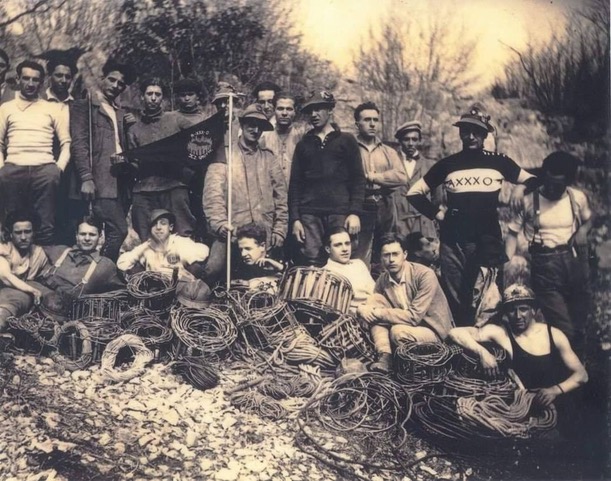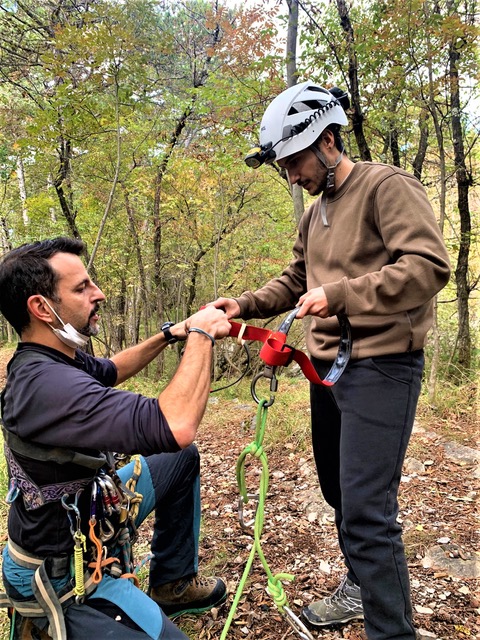By Alessandra Ressa
Photo credits Gruppo Grotte Associazione XXX Ottobre Trieste CAI
Have you ever thought of enrolling in a course of Speleology? Are you curious to know what lies beneath? Trieste’s very active speleological clubs are ready to take you there. With its over 2,500 mapped caves and hundreds more still unexplored, Trieste is a true heaven for speleologists and cave explorers.
There are at least eleven speleological clubs in town to choose from, some over 100 years old, each with experienced instructors teaching traditional and latest techniques.
Visiting Carso’s underground is a unique experience that deeply connects you to this beautiful territory. If you have been to Grotta Gigante, the biggest Karstic cave in the world, you have definitely caught a glimpse of the wonders under your feet. There is something adrenaline-filled and mysterious that make the many other, lesser known dark grottos, some impressively big, others claustrophobically small, impossible to resist.
The appeal of caves is, obviously, primal. They offer, in their darkness, both an instant physical reward – shelter – and something more metaphysical. For as many millennia as there have been humans, caves seem to have been considered a contact zone with the magical, the otherworldly, the irrational, the unconscious. Like Swiss cheese, our Carso is full of these hidden treasures that have attracted people for centuries.

Cave exploration in Trieste’s Carso began as early as the 1800s as a quest for water. The city’s booming economy and consequent demographic growth made water a priority for urban and suburban development. Teams of specialists began investigating natural openings, often digging and enlarging passages, thus giving birth to what was to become one of the most popular activities in Carso, cave exploration.
Since the beginning of the last century, these brave and passionate men and women, often relying on precarious equipment such as ladders and ropes, discovered and mapped over 2,500 caves, all registered today at Catasto regionale which can be found at www.catastogrotte.fvg.it.
Gruppo Grotte of Associazione XXX Ottobre CAI is one of the oldest clubs in town and is centrally located in via Battisti 22. Its members and experienced instructors share a unique passion, curiosity and knowledge of Trieste’s underground treasures. They are a restless team who periodically organize training courses for beginners, intermediate and advanced learners, as well as weekly activities and explorations for all members. And yes, they speak English.
As scary as it may seem to challenge gravity and hang from a rope over a deep dark hole, or crawl on all fours through narrow, muddy tunnels, the feelings of joy and relief that follow a speleological expedition are nothing if compared to the sensation of having accomplished something grand. And, with proper training, it’s quite safe. Learning to use the speleological equipment is fundamental for your own security and that of others. That is why you should attend a course. The instructors will follow you step by step not only to teach you the practical techniques to enter and exit a cave in complete security, but will also help you overcome your fears.

During a training course you will become familiar with the caving equipment: helmet, lighting, harnesses, abseil devices, as well as all the techniques of caving: walking, ramping, crawl crossing, abseiling, ascending the rope, rope progression. The school will provide all the equipment which you are free to use during the whole length of the course and for future excursions with valid membership, but you should have your own caving suit (a mechanics jumpsuit will do to begin with) and rainproof hiking boots (gripping rain boots are cheaper and even preferred to hiking boots for water and mud).
You will also need rubber gloves (those for gardening work best) and tights or pants, warm and comfortable fleece knit or wool, to put under the suit (Carso caves are not very cold, the average temperature in summer and winter is between 8° and 12°C but you have to wear the right type of clothes so as not to feel cold during the stops). An extra light for your helmet and extra batteries are a must.
Good working lights are essential when you enter a cave. You should always have two lamps plus extra batteries. In the old days, carbide lamps, or acetylene gas lamps, were used. They are simple lamps that produce and burn acetylene which is created by the reaction of calcium carbide with water. Acetylene gas lamps were used to illuminate buildings, as lighthouse beacons, and as headlights on motor-cars and bicycles. Portable acetylene gas lamps, worn on the hat or carried by hand, were widely used in mining in the early twentieth century. Today, a few nostalgic speleologists prefer their dim, flickering flame to the steady beam of the more practical battery operated ones.

Caving isn’t a walk in the park, it’s usually more like crawling through narrow passages, diving into dark unknown depths and getting yourself stuck in horizontal wedges, wondering if that second breakfast might have been a mistake after all. But that’s exactly what makes it so much fun to do! At least as a beginner, if you can fight off the nausea, heavy breathing, intense sweating, panic attacks and claustrophobic feeling along the way.
Being a claustrophobic caver, just like discovering too late you suffer from vertigo, might sound like a match made in hell, but it’s actually adding something to your experience. Caving is all about breaking new grounds, physically and mentally. Of course you need to be physically fit. It takes an enormous amount of strength and energy to pull yourself up and down, climb rocks and other obstacles. Make sure you always carry water and sweets. Be ready to get bruises all over your body. You’ll be black and blue for about a week, right until your next expedition underground.
Once inside, as a learner you will be too busy worrying about how to properly move about while attaching yourself to this or that rope (trying at the same time not to fall into the bottomless darkness below), to enjoy the magnificent views that surround you. But once you get the hand of it, you will be able to appreciate the stunning concretions typical of Karstic erosion and formation.
Flowstones, stalactites, stalagmites, helicities, soda straws and columns everywhere. Spectacularly colored wavy “ham slices” are also quite a sight. After heavy rains, some caves hide terraced pools and emerald pits. Speleo courses for beginners in most clubs usually last 4 to 6 weeks and include lessons in geology, as well as just about everything that you should know about caves, including getting familiar with the many living creatures that inhabit them. You’ll even learn how to make incredibly beautiful and resistant knots with your ropes. Your shoe laces will never look the same after that.
Every season is a good season for exploring caves in Carso. You can escape the steamy heat of summer, or the windy Bora spells, or the coldest peak of winter, and always find comfort in the tepid humidity of a cave. Each known cave has a distinctive number on a circular metal sign. As obvious as it may sound, you should never enter a cave on your own, and should always consult the regional Catasto grotte to access information about it through its identification number.
Caving is a Triestine thing that goes beyond the mere sports activity. It is an interest that creates strong intimate bonds, long-term romantic relationships, and life-long friendships. It’s a great way to meet new people and spend time outdoors sharing different backgrounds and common passions. And remember, caving is a little bit like going into space. It feels like minutes when you are inside, but when you emerge, you will be surprised to realize you have been under surface for several hours.





























